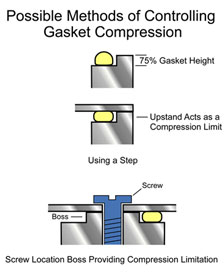

Form in Place (FIP) Gaskets
General Design Considerations
General Design Considerations
In order that the best shielding performance is attained, the surface that the gasket is applied to must have a relatively low electrical contact resistance. Surface oxidation or ‘heavy’ yellow chromate finishes can significantly reduce the performance of the gasket. Some finishes such as anodising are totally insulating and therefore those areas where a gasket is to be applied should be free from this type of surface treatment.
The gasket width will increase on compression. It is therefore important that there is sufficient clearance available at least on one side of the gasket. If the gasket is to be positioned in a channel then the channel must have a cross-sectional area larger than that of the gasket.
The recommended level of compression for a form-in-place gasket is 20 – 30%. It is, therefore, important that the gasket is sufficiently high that it is comfortably able to accommodate the tolerances on the enclosure where it is intended for use. There may be additional factors to consider such as thermal expansion/contraction, vibration or induced mechanical distortion as a result of assembly stresses.
In most cases, a conductive form-in-place gasket will provide some level of environmental / water sealing. However, if equipment is likely to be exposed to wet conditions frequently or for extended periods then it may be advisable to apply a separate non-conductive (unfilled) gasket alongside the external perimeter of conductive gasket. This will offer a higher level of protection to water ingress and/or hostile environments. Very often the two seals can be run in parallel (directly adjacent to one another), therefore requiring very little additional area over a single gasket. When applied in this way the conductive gasket is afforded maximum protection whilst the outer seal provides very efficient sealing (IP68 is possible). A further benefit is that as the outer seal contains no metallic filler thus eliminating the potential for galvanic corrosion at the enclosure seam. It is even possible to ‘tailor’ the external gasket to suit a particular environment. For example, it could be fluorosilicone to resist contact with oil, fuel or other organic contaminants.
If required we will normally recommend a material for a particular application. A full range of material types are available all manufactured and controlled on site. In this way, we can carefully control properties and ensure the performance of our materials.